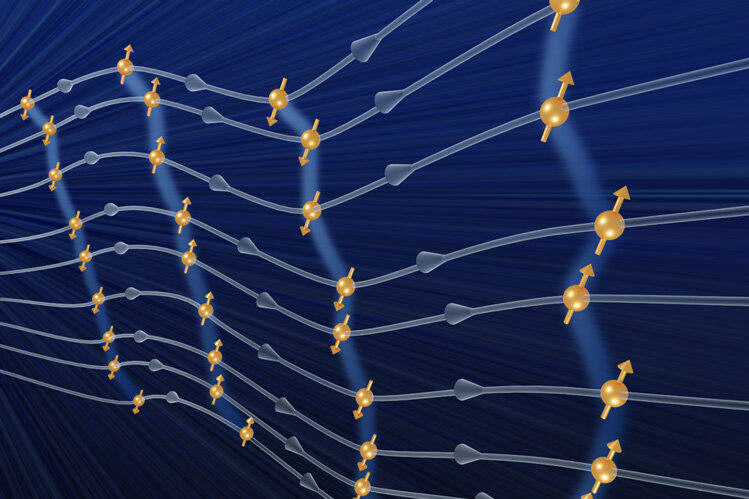博文
使用新的量子计算架构来创造时间晶体
 精选
精选
||
使用新的量子计算架构来创造时间晶体
诸平
据美国加州大学伯克利分校(University of California - Berkeley)2021年11月9日提供的消息,加州大学伯克利分校的物理学家姚诺曼(Norman Yao)五年前首次描述了如何制造时间晶体(time crystals),这是一种新的物质形式,其模式在时间而不是空间中重复。然而,与祖母绿(emerald)或红宝石(ruby)的晶体不同,尽管这些时间晶体只存在了几分之一秒,但是时间晶体的时代已经到来。自姚诺曼的最初提议以来,新的见解导致时间晶体有许多不同的形式,每一种都有自己独特的机制稳定下来。利用新的量子计算架构,几个实验室已经接近于创造一个时间晶体的多体局部样式(many-body localized version),它利用无序使周期性驱动的量子量子位(quantum qubits)保持在连续的亚谐波振动(subharmonic jiggling)状态,但量子位只能在此驱动的其他周期中振荡(详见:Using new quantum computing architectures to create time crystals)。
2021年11月4日发表在《科学》(Science)杂志上的一篇论文——J. Randall, C. E. Bradley, F. V. Van Der Grondena. Galicia, M. H. Abobeih, M. Markham, D. J. Twitchen, F. Machado, N. Y. Yao, T. H. Taminiau. Many-body-localized discrete time crystal with a programmable spin-based quantum simulator. Science, 4 Nov 2021. DOI: 10.1126/science.abk0603. https://www.science.org/doi/10.1126/science.abk0603, 其中, 姚诺曼和他的QuTech的同事们报道创建了一个多体的局部离散时间晶体,持续了大约8秒,对应于800个振荡周期。QuTech是荷兰代尔夫特理工大学(Delft University of Technology)和荷兰应用科学研究院(TNO)之间的协作,属于荷兰一个独立的研究小组。他们使用了一种基于金刚石的量子计算机,量子比特,类似于数字计算机中二进制比特,是嵌入金刚石中的碳13原子(13C)的核自旋。
QuTech的乔·兰德尔(QuTech's Joe Randall)说:“虽然一个完全隔离的时间晶体原则上可以永远存活,但任何真正的实验实施都将由于与环境的相互作用而衰减。进一步延长时间晶体寿命是下一个前沿。”
今年夏天首次在预印本文库arXiv上发布的结果,在谷歌、斯坦福和普林斯顿的研究人员使用谷歌的超导量子计算机(Google's superconducting quantum computer)——Sycamore几乎同时进行的实验中得到了复制。这次演示使用了由超导铝条制成的20个量子位元,持续了大约八分之一秒。谷歌和QuTech的时间晶体都被称为物质的弗洛凯相(Floquet phases),是一种非平衡物质(non-equilibrium material)。
QuTech首席研究员蒂姆•塔米尼奥(Tim Taminiau)表示:“多个实验突破同时发生,这是非常令人兴奋的。所有这些不同的平台相互补充。谷歌实验使用了两倍多的量子位;我们的时间晶体寿命要长10倍左右。”
QuTech的团队以正确的方式操纵了9个碳-13量子位元,以满足形成多体局域时间晶体的标准。加州大学伯克利分校物理学副教授姚诺曼说:“时间晶体可能是物质非平衡相最简单的例子。QuTech系统能够完美地探索其他非平衡现象,例如弗洛凯拓扑相(Floquet topological phases)。”
几个月前(即2021年6月11日),在《科学》( Science)杂志上发表了另一项关于时间晶体的研究——A. Kyprianidis, F. Machado, W. Morong, P. Becker, K. S. Collins, D. V. Elsel. Feng, P. W. Hess, C. Nayak, G. Pagano, N. Y. Yao, C. Monroe. Observation of a prethermal discrete time crystal. Science, 11 Jun 2021, Vol 372, Issue 6547, pp. 1192-1196. DOI: 10.1126/science.abg8102. https://www.science.org/doi/10.1126/science.abg8102
这篇论文也涉及到姚诺曼(N. Y. Yao)的团队。在这篇论文中,研究人员观察到一种所谓的预热时间晶体,其中的次谐波振荡(subharmonic oscillations)通过高频驱动稳定下来。这项实验是在马里兰大学门罗的实验室(Monroe's lab at the University of Maryland)进行的,使用的是捕获原子离子的一维链,这个系统在五年前就观察到了时间晶体动力学的第一个特征。有趣的是,与代表固有量子弗洛凯相的多体定域时间晶体不同,预热时间晶体(prethermal time crystals)可以作为物质的量子相或经典相存在。
许多悬而未决的问题仍然存在。时间晶体(time crystals)有实际应用吗?耗散能帮助延长时间晶体的寿命吗?更一般地说,受驱动的量子系统是如何以及何时达到平衡的?报道的结果表明,固体中的自旋缺陷对于实验研究统计物理学中的这些重要的开放问题而言,是一个灵活的平台。加州大学伯克利分校的研究生弗朗西斯科·马查多(Francisco Machado)说:“将自旋与周围环境隔离开来的能力,同时仍然能够控制它们的相互作用,为研究信息是如何保存或丢失的提供了一个惊人的机会。看看接下来会发生什么,将是非常有趣的。”
上述介绍,仅供参考。欲了解更多信息,敬请注意浏览原文或者相关报道。
Abstract (DOI: 10.1126/science.abk0603)
The discrete time crystal (DTC) is a non-equilibrium phase of matter that spontaneously breaks time-translation symmetry. Disorder-induced many-body-localization can stabilize the DTC phase by breaking ergodicity and preventing thermalization. Here, we observe the hallmark signatures of the many-body-localized DTC using a novel quantum simulation platform based on individually controllable 13C nuclear spins in diamond. We demonstrate long-lived period-doubled oscillations and confirm that they are robust for generic initial states, thus showing the characteristic time-crystalline order across the many-body spectrum. Our results are consistent with the realization of an out-of-equilibrium Floquet phase of matter and introduce a programmable quantum simulator based on solid-state spins for exploring many-body physics.
Prethermal time crystal (DOI: 10.1126/science.abg8102)
Characterizing and understanding different phases of matter in equilibrium is usually associated with the process of thermalization, where the system equilibrates. Recent efforts probing nonequilibrium systems have revealed that periodic driving of the system can suppress the natural tendency for equilibration yet still form new, nonequilibrium phases. Kyprianidis et al. used a quantum simulator composed of 25 trapped ion qubits and spins to observe such a nonequilibrium phase of matter: the disorder-free prethermal discrete time crystal. The flexibility and tunability of their quantum simulator provide a powerful platform with which to study the exotic phases of matter.
Science, abg8102, this issue p. 1192
Abstract (DOI: 10.1126/science.abg8102)
Extending the framework of statistical physics to the nonequilibrium setting has led to the discovery of previously unidentified phases of matter, often catalyzed by periodic driving. However, preventing the runaway heating that is associated with driving a strongly interacting quantum system remains a challenge in the investigation of these newly discovered phases. In this work, we utilize a trapped-ion quantum simulator to observe the signatures of a nonequilibrium driven phase without disorder—the prethermal discrete time crystal. Here, the heating problem is circumvented not by disorder-induced many-body localization, but rather by high-frequency driving, which leads to an expansive time window where nonequilibrium phases can emerge. Floquet prethermalization is thus presented as a general strategy for creating, stabilizing, and studying intrinsically out-of-equilibrium phases of matter.
Norman Y. Yao, Chetan Nayak. Time crystals in periodically driven systems, Physics Today, 2018, Volume 71, Issue 9. DOI: 10.1063/PT.3.4020.
https://physicstoday.scitation.org/doi/10.1063/PT.3.4020
When the discrete time-translation symmetry of isolated, periodically driven systems is spontaneously broken, a new phase of matter can emerge.
https://blog.sciencenet.cn/blog-212210-1312021.html
上一篇:意外的化学反应可能提供新的工业应用
下一篇:电动汽车能帮助加强电网吗?
